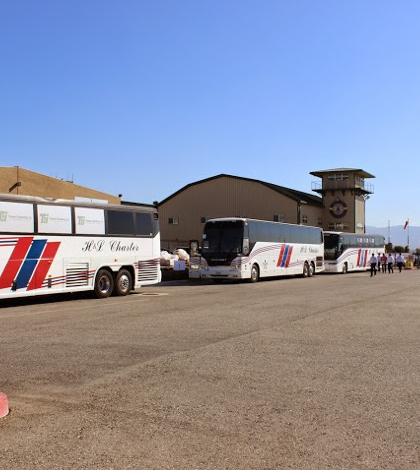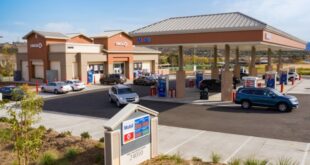Members of the real estate industry get an up-close look at the region’s industrial market, in particular projects that are planned or under construction. The market is clearly emerging from hit it took during the recession.
About 275 real estate professionals took part Thursday in NAIOP Inland Empire’s annual bus tour of industrial properties in the two-county region.
They must have loved what they saw.
Nearly 65 projects, either built or under construction, from Ontario and Chino on the west end to Perris and Moreno Valley on the east. All of them either for sale or have space to lease, and many of them 500,000 square feet or larger, the size that currently dominates the market.
“People are going to see more projects under construction than they have in the past few years,” said Robert Evans, executive director of NAIOP Inland Empire, the day before the bus tour.
This year’s tour, believed to be the 20th conducted by NAIOP Inland Empire, originated at Chino Airport. It featured seven buses and attracted participants from San Francisco, Chicago and Florida.
“On the whole, we’re looking at a healthy industrial market, a lot better than it was a few years ago,” Evans said.
Market data provided by CBRE Group Inc., the Inland region’s largest commercial real estate brokerage, support that claim.
More than 12.3 million square feet of industrial space – about 25 buildings – is now under construction in Riverside and San Bernardino counties, according to CBRE.
The region’s vacancy rate, 4.6 percent, is well below the 7.0 national rate, and the two-county region recorded 25.5 million square feet of total activity during the first nine months of this year, CBRE found.
That’s a major improvement compared with five years ago when, at the height of the recession, there was so little activity that NAIOP Inland Empire didn’t bother to schedule a bus tour. Instead, the chapter held a “virtual” tour of the region, in which visual displays of projects planned or under construction were used.
Perhaps nowhere else in the United States, or the world, are there so many Class A industrial properties available in one market, said Dan de la Paz, senior vice president with CBRE Group Inc. in Ontario.
“In other markets, you might have five industrial deals working at one time,” said De la Paz, a tour guide on one of the west end buses. “Here were looking at more than 60, and we’re not even at full strength. I don’t think there’s any question that this is the greatest industrial market in the United States.”
De la Paz, while dispensing information on various projects, was effusive in his praise of the Inland industrial market but quick to point out that it isn’t close to where it was in 2006 and 2007, when it was at its peak.
“It’s more like where it was in 2003 and 2004,” said De la Paz, who spoke along with Joey Sugar, also a senior vice president with CBRE Ontario. “Buildings go on the market now and it might be six months or a year before someone does something with them. In 2007, buildings were pre-leased 60 days before they were finished. We’re not to that point yet.”
Many of the projects on the tour covered at least 500,000 square feet, with some surpassing one million square feet and several topping two million square feet.
“It’s definitely been a top-down recovery,” De la Paz said. “The developers with big balance sheets were the first to re-enter the market, and they wanted to build larger projects. I think there’s strong demand building up for projects in the 200,000-square-foot range. All it will take is for one or two developers to get that started.”
Virtually everyone on the tour was already familiar with the Inland industrial market – many were looking at projects they helped build, sell or lease – but that didn’t dampen their enthusiasm for inspecting the market.
“I think I’m going to see a validation of the Perris-Moreno Valley market being a destination for Fortune 500 companies,” said Jeff Trenton, president of Proficiency Capital LLC, a real estate development company in Los Angeles that has built multiple projects in the Inland region.
“Kraft, Amazon, Lowe’s [Home Improvement] and Walgreens are all in that market and they’re all good corporate citizens creating jobs,” Trenton said shortly before boarding one of the buses that toured the east end. “Ten years ago you could never have seen that happening, but you can see it now.”
The Inland industrial market should stay up for at least two more years, said Kevin Ivey, marketing director for KPS Construction in Brea.
“The biggest challenge is going to be finding people to work in all of these places that are under construction,” said Ivey, whose company has worked in the Inland Empire for more than 10 years, including construction of the 1.7-million-square-foot Whirlpool facility in Perris. “A lot of subcontractors left the industry when the recession hit, and they didn’t come back.”
Ivey called the recovery “steady,” and said that might be better in the long-run.
“It’s not a roller coast ride, and that’s good,” he said.
This year’s bus tour highlighted more than the Inland Empire’s industrial market, said Chuck Belden, executive director of Cushman & Wakefield’s Inland Empire office and a tour guide on one of the east end buses.
“You can see from all of the growth that the Inland Empire is part of the global economy,” Belden said. “ But I wouldn’t call this a boom market, because that sounds like something that comes and goes quickly. This is more sustainable growth.”
 IE Business Daily Business news for the Inland Empire.
IE Business Daily Business news for the Inland Empire.


